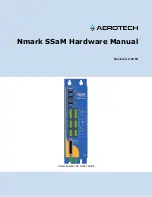
NovaLynx Corporation________________________________________________________________________________
200-WS-02E
Page 9
December 2018
10
FUNCTIONAL TESTS
The following checks can be done with an ohm-meter after the sensor has been dis-mounted from the
weather station mast or tower. These tests can help determine whether the sensor needs repair or
adjustment.
10.1
Anemometer Electrical Test
Set the ohm-meter to a low resistance range and touch its leads together to check for zero ohms. If it is
an analog meter adjust the dial to read zero ohms. Connect the ohm-meter to the white and brown
signal wires from the anemometer (polarity is not important).
Rotate the cup assembly slowly until you notice the meter reading drop to less than 10 ohms. Continue
to rotate until the switch opens (high resistance). Do this for each of the 3 magnets in the cup
assembly. If the meter always reads a low resistance then the reed switch is not opening (the contacts
may have welded together) or there may be a short circuit in the cable. If the switch never closes then
there may be a break in the cable or the magnets are not near enough to activate the switch. Check
the distance between the cup assembly and the base. The gap should be about 1/16" (1.6 mm).
10.2
Potentiometer Electrical Test
Wind vane calibration involves checking the potentiometer output and verification of the sensor
alignment to north.
Set the ohm-meter to the 20k range (or greater range if needed). Connect the black meter lead to the
black sensor wire, and the red meter lead to the red sensor wire. The reading on the meter should be a
stable output of about 20,000 ohms (+/-20%). Rotate the vane once around while watching the meter
to ensure the reading does not change.
Connect the red meter lead to the green wire. Observe that the meter reading changes as you rotate
the vane. Check the "dead band" where the meter goes to "infinite" and verify that the counterweight
is pointing the same direction as the North indicator label on the base of the sensor. Now rotate the
vane slowly
counter-clockwise
and observe that the resistance changes smoothly from near zero to
the maximum just before hitting the "dead band" again as you approach north.
If the "dead band" does not align with the North label then the position of the vane can be changed to
correct the alignment:
1.
Using a 1/16" Allen wrench, loosen the potentiometer set screw located on one side of the hub
(See Figure 1 on Page 6).
2.
Lift upwards to remove the vane assembly from the sensor. Note that the potentiometer body
is bonded to the sensor body and should not move.




























